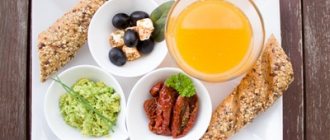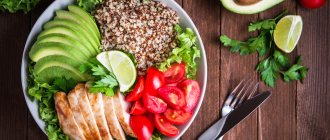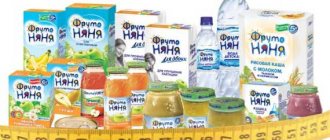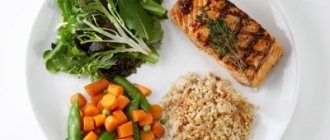Features of the elderly
The aging of the body cannot be stopped. Regenerative capabilities gradually decrease, psychomotor and protective functions slow down, and the activity of the gastrointestinal tract weakens.
To maintain good health in old age, it is important to maintain a balanced energy balance through a well-chosen daily diet. When developing a menu, several factors characteristic of older people are taken into account:
- slow metabolism;
- developing pathologies;
- sedentary lifestyle;
- development of constipation;
- frequent use of medications.
What diet is indicated for diabetes mellitus in the elderly
Lack of insulin in the blood, which breaks down glucose, leads to irreversible consequences, the development of diabetes mellitus with a gradually increasing degree. To curb the development of the disease, it is necessary to introduce a diet that will reduce glucose levels, correct carbohydrate metabolism and at the same time provide all the necessary vitamins and microelements.
A diet for older people suffering from diabetes has no deadlines and should be included in a person’s usual diet. The diet limits the intake of fats and carbohydrates and reduces the total weight of food per day to 3 kg.
The correct diet for older people with diabetes involves consuming one and a half to two liters of fluid per day, and food five times a day. Cooking excludes frying; you can boil, steam or bake in the oven. Sugar will have to be completely eliminated from the diet. The use of fructose and sweeteners is allowed, for example, xylitol, which can be consumed in an amount of 40-50 grams.
Carbohydrates, which are a source of energy, are not completely excluded from this diet, but instead of sugar, cereals, fruits and vegetables, bran bread, and special dietary products are present. Due to an excess of fructose, some fruits must be soaked in water before consumption.
Carbohydrate metabolism impaired in diabetes also affects fat deposition in older people, so the diet reduces the fat content of foods to 70-80 grams, of which 30 grams. must be of plant origin.
To help the liver function, you should add cottage cheese, sea fish and seafood rich in iodine to your diet. It is also worth monitoring the level of vitamins in the body, since diabetes mellitus is often the cause of a lack of B vitamins in older people, as well as vitamins A and C. When preparing a diet, foods high in these vitamins must be included in it.
Necessary products that will form the basis of a diet for older people with diabetes:
- Various breads up to 300 gr. per day: from coarse flour, with bran, protein-wheat;
- Lightly salted herring;
- The cheeses are light, without pungency;
- Lean ham or sausage;
- Salads from fresh vegetables with vegetable oil;
- Soups made with milk, vegetable broth or cereal decoctions, or weak fish or meat broths;
- Lean meat, fish, chicken breast, turkey;
- Eggs are desirable as an integral part of any dish or in the form of omelettes;
- Fermented milk products, except sour cream and cream due to their fat content;
- Cereals, ideally buckwheat and oats;
- Legumes;
- Vegetables that are low in natural sugars and can be eaten in large quantities;
- Sweet and sour fruits and berries, live or baked, as well as compotes with the addition of xylitol;
- Sauces based on light broths: vegetable, fish, weak meat;
- Tea, coffee without sugar;
- Juices with low sugar content;
- Vegetable oil and butter in limited quantities.
If you have diabetes, you should absolutely not include in your diet:
- Confectionery with sugar;
- Any baked goods;
- Sweet purchased drinks, as well as tea, coffee with sugar;
- Fruits and berries with high levels of fructose;
- Fatty meat, as well as poultry and fish;
- Salo;
- Hot spices;
- Smoked and pickled products;
What menu can you create for the day for this diet:
- First meal. Buckwheat on water with meat pate, a sandwich of rye bread with butter and a cup of tea.
- Second meal. Cottage cheese, bran bun and kefir.
- Third meal. Vegetable puree soup, boiled meat puree and apple, you can drink rosehip decoction.
- Fourth meal. Tea with milk.
- Fifth meal. Stewed cabbage with boiled fish, carrot cutlets and tea.
- Kefir at night
Principles of nutrition
To avoid the negative consequences caused by natural age-related changes, as well as to maintain vigor for older people, following some important principles of proper nutrition:
- Diet variety. The daily menu must include fruit and vegetable varieties, greens, legumes and grains, dairy products, meat, fish, cereals, eggs, nuts.
- Compliance with drinking regime. After waking up in the morning, it is recommended to immediately drink a glass of filtered water. Drink enough liquid throughout the day.
- The predominant use of vegetable fats in cooking.
- Energy balance of nutrition. It is important to organize calorie counting throughout the day. This will allow you to avoid overeating, which has a negative impact on the body. At the age of over 60 years, the optimal daily energy intake varies between 2100-2350 kcal. After 80 years, this figure is 1800-2000 kcal.
- Prevention of atherosclerosis. The most common diseases that develop in old age are vascular atherosclerosis. It is important to reduce the risk of atherosclerotic plaques by reducing the consumption of animal fat, giving preference to fish.
- Fractional meals. It is advisable to consume food in small portions 4-6 times throughout the day. It is recommended to maintain the interval between dinner and falling asleep within 3.5-4 hours. This is important for slow metabolism, as it prevents the occurrence of excessive gas, heartburn, and sleep disturbances.
- Utility priority. When compiling a diet, preference should be given to easily digestible varieties of foods that have a beneficial effect on the functions of the gastrointestinal tract.
- Compatibility with medications. When your doctor prescribes medications, you should consult about combining them with specific types of food. Medicines often have an appetite suppressant effect, which impairs the functioning of taste buds.
- Determining the convenient consistency of food consumed. Dental health remains a common problem among older people. If there are difficulties in chewing, then preference is given to ground foods.
It is important not only to choose healthy products wisely, but also to prepare them correctly, preserving the vitamins and mineral compounds they contain. When served, dishes should look aesthetically pleasing, awakening the appetite. When preparing a diet, the individuality of the elderly person is taken into account, his food preferences, as well as his general health, are taken into account.
General principles of proper diet for an old person
To avoid chronic ailments typical of older people, to support the body and improve its functionality, you need to adjust your diet. To do this, you must follow the following nutritional principles:
- Control calories. The number of calories that enter the body from food should be equal to the actual energy expenditure.
- Follow an anti-sclerosis diet. The diet needs to be replenished with products with anti-sclerotic effects.
- Create a balanced, varied menu. A person should eat food rich in all essential nutrients, vitamins, and minerals.
- Include easily digestible foods in your diet. A person should consume foods that are easily digested and moderately activate the secretory and motor function of the gastrointestinal tract.
- Strictly follow the meal schedule. It is important to create a meal schedule by the hour, evenly distributing the daily diet.
When preparing a diet, an elderly person must take into account the state of certain organs and systems, metabolic characteristics, and eating habits.
Mode
People over 60 years of age should eat regularly, avoid long gaps between meals, and not overeat. This way, foods will be digested normally, and all organs involved in the absorption of nutrients will not be subject to excessive stress.
With age-related changes in the body, the functionality of the digestive system decreases, so heavy meals disrupt their functioning.
Important! After 60 years, men and women should switch to four meals a day. Lunch and breakfast should be the most satisfying, and for dinner it is better to eat light foods (low-fat fermented milk drinks, fresh vegetables or fruits).
Doctors recommend periodically arranging fasting days. Then a person should consume only cottage cheese, kefir, and plant products throughout the day.
People of the “third” age are prohibited from starving completely.
If you have chronic diseases, you should switch to 5 meals a day. This is necessary to relieve the digestive organs, speed up metabolism, and improve general condition.
Serving Size
A person over 60 years of age should eat in moderation. He should eat food 4 times a day, but in small portions.
The following is a table showing the daily amount of products in grams:
| Product | Male under 65 years old | Woman under 65 years old | Man over 65 years old | Woman over 65 years old |
| Rye flour bread | 100 | 100 | 100 | 100 |
| Bread made from millet flour | 200 | 150 | 150 | 120 |
| Class A pasta | 10 | 10 | 10 | 10 |
| Cereals and beans | 30 | 30 | 25 | 25 |
| Potato | 250 | 200 | 200 | 150 |
| Other vegetables | 400 | 400 | 350 | 350 |
| Fruits, berries | 300 | 300 | 250 | 250 |
| Dry fruits | 25 | 25 | 25 | 25 |
| Sugar | 50 | 50 | 50 | 50 |
| Diet meat | 100 | 75 | 60 | 60 |
| Milk, kefir (low fat) | 150 | 150 | 150 | 150 |
| Cottage cheese | 100 | 100 | 100 | 100 |
| Eggs, per week | 3 pcs. | 2 pcs. | 2 pcs. | 2 pcs. |
| Vegetable oil | 30 | 20 | 20 | 20 |
| Butter | 10 | 10 | 10 | 10 |
If it is easier for a person to focus on food portions, then every day he should consume:
- Bread, cereals – 5 to 6 servings. 1 serving is 1 slice of bread, 30 g of cereal, ½ cup of porridge.
- Vegetables – from 2 to 2.5 servings. A person can consume 1 cup of vegetables or ½ cup of chopped vegetables (raw or cooked) per meal.
- Fruits – from 1.5 to 2 servings. At a time you can eat 1 medium piece of your favorite fruit, ½ cup chopped (fresh, cooked or canned), the same amount of dried fruits, freshly squeezed juice.
- Milk and products made from it. A single serving consists of 220 ml of milk, yogurt (low fat), 45 g of hard cheese.
- Lean meat, fish, beans, eggs, nuts - from 1.5 to 2 servings. For 1 meal, a person can eat about 90 g of meat or fish (per day - about 200 g), 1 cup of beans, 2 eggs, 100 g of peanut butter, 25 g of nuts.
When eating small portions, food is broken down faster and nutrients are absorbed.
Healthy foods
People of the “third” age suffer from slow metabolism, decreased appetite, and various negative reactions after taking medications or overeating. To reduce negative effects, you need to include the right foods in your diet:
- Proteins can be obtained from seafood, which are better digestible. Lean meat and eggs can be consumed 1-2 times a week. Low-fat fermented milk products are suitable for daily consumption.
- Sources of fats are unrefined vegetable oils. They can be used for dressing salads and porridges.
- Complex carbohydrates, as well as fiber, can be obtained from whole grain bread, cereals, and plant products.
Important! People over 60 years of age need to saturate their body with vitamins and minerals. The nutrients they get from food are not enough, so it is recommended to take vitamin and mineral complexes.
What to refuse and what food to limit
To avoid such common problems as obesity, heart and vascular diseases, diabetes, you need to limit the amount of sugar, baked goods, and sweets. You can replace harmful foods with xylitol (a sweetener), berries, fruits, and honey.
To avoid unnecessary stress on the digestive system, avoid spicy, smoked, and salty foods.
It is strictly forbidden for older people to indulge themselves in fast food, processed foods, carbonated drinks, sausages, fatty meats, and milk. A person in the “third” age can afford 150 g of dry wine.
You may also be interested in: Healthy and harmful foods
Energy balance
To avoid obesity and related problems, an elderly person must control their daily caloric intake. The approximate energy value of the menu for people over 60 years old is from 2300 to 2100 kcal, and from 80 years old – from 2000 to 1900 kcal. During physical activity, the number of calories can be increased slightly.
The protein requirement in old age is very important for maintaining adequate body weight and reducing the risk of malnutrition and is 0.75-1 g per 1 kg of weight. Older people should consume 65 to 70 g of fat (dairy products, vegetable oils). Carbohydrate content ranges from 275 to 340 g, of which 10-15% are simple carbohydrates.
Menu specifics for men and women
Women over 60 years old are recommended to replenish their diet with healthy plant foods, low-fat dairy products, cereals, herbs, as well as foods containing protein, calcium, and iron. Read more about proper nutrition after 60 years for women in the article at the link.
Daily menu for women over 60 years of age:
- Breakfast - cottage cheese, dry fruits, nuts, green tea or freshly squeezed juice.
- Lunch – fresh, steamed or baked fruit.
- Lunch – soup or buckwheat with meat, vegetables, cookies, tea.
- Dinner – porridge with water, baked (without oil) fish, vegetable salad.
Important! Supplement your diet with seasonal vegetables and fruits native to your region.
A man's daily diet contains more calories:
- Steamed or oven-baked fish, sliced vegetables, unsweetened tea.
- Fruit salad.
- Low-fat borscht with meat, a little sour cream, a slice of bread, baked apples with honey, tea.
- Cottage cheese casserole, kefir.
Menu options for men are different, the main thing is that he eats 1 kg of vegetables and fruits, 200 g of fish and meat.
You may also be interested in: Fasting day on eggs
Will separate nutrition help your health and figure?
Proper nutrition: menu, recipes
Cottage cheese casserole with proper nutrition
Healthy food
The organization of a balanced, healthy diet aimed at older people should begin with an analysis of the list of products that can benefit the body. Of course, personal preferences are taken into account, as well as possible individual intolerance to specific food varieties.
A fairly extensive list of products that serve as a source of compounds important for maintaining health and energy balance is allowed to be included in the menu of older people.
Squirrels
The body must receive a variety of protein foods. The protein contained in seafood is easier to digest, which is important when metabolic processes slow down with age. More often they include fish in the diet, in which the protein level is on average 15-20%.
The benefits of fish dishes are due to the inclusion of fatty acids, essential amino acids, various compounds beneficial to the body (for example, iodine, calcium, phosphorus), as well as vitamins, among which are ascorbic acid, A, E, D, group B.
Boiled or steamed lean meat and eggs are allowed. Includes nuts and seeds, which saturate the body with vitamins and polyunsaturated acids.
Fats
A balanced menu necessarily contains foods containing fat, but older people should give preference to vegetable oils, choosing unrefined varieties for use as a dressing.
Carbohydrates
Complex carbohydrates play an important role in a diet developed for an elderly person. They are absorbed more slowly, which helps normalize digestive processes, promote a long-lasting feeling of fullness, and prevent excess weight gain. Complex carbohydrates contain pectin, glycogen, starch, and fiber.
These beneficial compounds can be found in vegetables, various cereals, fruits, and bread products made from coarsely ground flour.
Macro- and microelements and vitamins necessary for the body
Natural aging of the body is reflected in a decrease in the quality of absorption of various useful elements.
It becomes relevant for people over 60 years of age to include in the menu not only fruit and vegetable products rich in compounds important for life. It is necessary to take mineral and vitamin complexes recommended by your doctor.
Calcium
The older a person gets, the more often he or she develops calcium deficiency, which leads to a decrease in bone strength and the development of osteoporosis.
To prevent such dangerous conditions, it is important to consume dairy products, choosing fermented milk varieties with low fat content. Ryazhenka, kefir, and natural yogurt are beneficial.
The role of vitamins in nutrition
Older people need to consume enough vitamins and minerals every day, as some of them do not accumulate in the body and require regular intake. For example, vitamin C is vital for humans and must be taken every day. It participates in cholesterol metabolism, affects the walls of blood vessels, and regulates oxidative processes. The presence of vitamins E, B and P in the diet is also very important. B vitamins are extremely necessary in the body, as they have a very wide range of effects, so it is imperative for all older people to consume more foods containing them. Vitamin A is also very important, as it affects the condition of the mucous membranes, eyes and skin.
High-quality and varied food largely provides a person with all the necessary vitamins and mineral components. However, this is not always enough. Even if a person eats a varied and nutritious diet and it is summer or autumn, and the table is full of fruits, berries and vegetables, often the aging body still lacks certain substances. In such cases, it is advisable to take vitamin complexes in tablet or other form, after consulting with your doctor first.
Rational consumption of food
In old age, subject to a rational selection of food intake and the inclusion of gymnastic exercises and walks in the daily routine, it is possible to maintain cheerfulness, good physical shape, activity, a clear mind, and strong memory.
Rational consumption of food usually becomes relevant after reaching retirement age, when awareness of the value of health appears. It will help when independently developing a diet for the elderly to follow a number of recommendations from the World Health Organization, highlighting several types of products and their daily share.
Table 1. Daily intake of basic products
| List of products | Daily norm | Note | |
| 1 type | Potatoes, cereal dishes, bakery products | 40 % | Over the age of 65, daily intake should not exceed 1.5 kg |
| Type 2 | Vegetables, greens, fruits | Up to 35% | The daily recommended intake is 400 g. Dried and frozen varieties are allowed. Canned foods excluded |
| Type 3 | Protein types - fish, poultry, nuts, eggs, meat, legumes | ≈ 20 % | It is recommended to select lean meat varieties |
| 4 type | Dairy products | ≈ 5 % | Preference is given to products with low fat content |
| 5 type | Fats, sugar, oils, salt, drinks, flour products | ≈ 5 % | Select based on health status |
Features of the boarding house menu
When compiling the diet and diet of our esteemed residents, we pay special attention to the calorie content of dishes and the balance of nutrients in order to support the energy of a weakened body:
- proteins, taking into account the composition of amino acids;
- vegetable or animal fats and their rational ratio;
- carbohydrates.
Steamed dishes are considered the most healthy. They are well absorbed by the body, have a sufficient amount of useful substances and do not cause health problems for older people.
A personal nutrition program, assistance to needy residents in eating, a varied menu of quality products, service by trained staff, a separate approach to each person, allows us to create ideal living conditions for our guests. Many of them come to us on the recommendations of friends who have experienced the comfortable conditions of our service.
In our boarding house, guests not only have a good rest, but also become healthier. Relatives notice positive changes in the lives of loved ones and thank the boarding house staff for their kind attitude and attention to their relatives.
Regime organization
Knowledge of the basic principles of choosing products for the menu in old age allows you to easily organize an individually oriented diet and diet.
Having developed a meal schedule based on the recommendations of experts, it is important to adhere to it. When determining a menu that involves eating food 4-6 times a day, it is taken into account that the main meals should be the most nutritious. For snacks, choose light, low-calorie dishes.
For a diet with an average intake of 2000 calories, the proportion of free sugar should be 5%. The inclusion of fructose and sucrose in drinks and ready-made dishes is taken into account, and not just the use of granulated sugar for tea or coffee. An excess of free sugars (more than 50 g per day) negatively affects the condition of tooth enamel, causes excess weight gain, and causes the development of diabetes, hypertension, and cardiovascular pathologies.
It is important to consume no more than 5-6 g of salt per day, given its inclusion in a variety of finished products, for example, bread. It is advisable to add a minimum amount of salt to food during cooking.
Of the total daily calorie content, the share of proteins varies between 12-15%. Calculate the average requirement in old age with good health, taking into account body weight. It is recommended to maintain a ratio of 1 g/kg. In case of pathological changes, the protein norm is increased. It can be 1.5 g/kg.
They prefer boiled, stewed, baked dishes. It is useful for elderly household members to steam meat and fish delicacies. Try to reduce the consumption of fried foods as much as possible.
You need to eat vegetables, beans, and other legumes, as well as fruits in small portions daily. They are usually used to organize possible additional snacks. Whole grains will benefit you.
Fruit and vegetable varieties rich in fiber are recommended to be consumed raw. Usually they are first crushed using a blender or grater. The inclusion of such food in the daily menu helps to normalize the functions of the gastrointestinal tract.
Fish, as a priority source of protein, is introduced into the diet 2-3 times a week. Alternate it with eating lean meats. It is recommended to cook first courses in rich meat broth no more than once every 6-7 days. It is useful to eat a handful of nuts or seeds every day - sunflower, pumpkin.
Legumes that help prevent or slow down the development of cardiovascular pathologies and osteoporosis can be used for cooking every other day. Contraindications are taken into account, including kidney and joint diseases, gout.
Eggs (1-2 pieces) are allowed for consumption every 3-7 days. As a salad dressing for adding to porridge, unrefined varieties of vegetable oil are used, which contain a large amount of healthy fats.
Dill, lettuce, parsley and other varieties of fresh herbs, which saturate the body with a variety of vitamins, allow you to diversify the menu.
Fasting in old age is contraindicated, but fasting days can be beneficial in the absence of serious pathological abnormalities after receiving medical advice.
Healthy food for those over 80
After 80 years of age, a person becomes predisposed to excess weight, and the risk of developing the disease increases. To avoid this, you need to eat 5 times a day in small portions.
Expert opinion
Taisiya Galushina
general practitioner, nutritionist, transfusiologist, expert of the Gercules.fit project
Aging is preceded by the accumulation of damaged DNA sections throughout life, this is the destruction of proteins in molecules. It is important to monitor the intake of protein in the body to compensate for this process. The ideal ratio is 1 g of protein per kg of weight per day. Excess carbohydrates and proteins in the diet contribute to atherosclerosis, osteoporosis, neurodegenerative diseases, cancer, and insulin insensitivity. Diet plays a more significant role in maintaining genomic stability than previously thought. B vitamins (B3, B9, B12), zinc and magnesium are necessary for normal DNA synthesis. Therefore, after fifty years, it is recommended to eat foods with a high content of B12 and B9. People following a vegan diet also need specific vitamin supplements, since B12 is only found in animal products. Eating foods and oils rich in vitamin E can enhance cellular immune function in older adults. The intake of the amino acid tryptophan and fiber with food has a beneficial effect on the structure and function of the intestinal microflora and, accordingly, on the secretion of its factors that regulate multiple processes responsible for inflammation. Manipulating the composition of the intestinal microflora appears to be another effective way to increase life expectancy and improve well-being in old age. To date, the original causes of aging are still not clear, and the most proven types of nutrition are the Mediterranean and Okinawan diets. The general aspects are: high consumption of whole grains, legumes, fish and seafood, fruits and vegetables, moderate consumption of dairy products (mainly cheese and yogurt) and wine, low consumption of red meat, poultry and sweets. Many studies have confirmed the relationship between adherence to the Mediterranean diet and longevity, as well as a reduced risk of developing pathologies, and residents of the island of Okinawa have the longest life expectancy.
To support the functioning of the body, you need to follow these nutritional rules:
- Eat lean fish, meat, and fats before 12 noon.
- Dine on fermented milk products, avoid salt and extractives.
- Boil, stew, steam the products.
- Avoid sweets, sugar, and animal fats.
- The menu of an old person after 80 years should include side dishes and vegetable dishes (salads with butter, cabbage, tomatoes, pumpkin, zucchini, greens). Limit the amount of legumes and spinach.
- Drink green tea, weak coffee, freshly squeezed juices, water.
It is also important to remember that the menu should be varied, so look for new recipes.
Sample weekly menu
Creating a menu that benefits older people is always personal-oriented, but the basis for development is usually the example offered by experts.
Table 2. Weekly menu
| Breakfast, 7-00 | Lunch, 11-00 | Lunch, 13-00 | Afternoon snack, 16-00 | Dinner, 19-00 |
| MONDAY | ||||
| Rice milk porridge; boiled grated carrots with apple; tea; cookie | Green tea; slice of rye bread with cheese | Vegetable salad with herbs; green pea soup; fish cutlet with mashed potatoes; rosehip compote | Glass of fermented baked milk | Boiled vegetables with veal cutlet; baked apple |
| TUESDAY | ||||
| Oatmeal milk porridge; curd cheesecakes; green tea | Drink made from chicory with added milk; ham sandwich | Cauliflower based soup; stewed lean beef with vegetables; cranberry compote | Large apple | Cheese eggplant casserole with mashed potatoes, jelly with fresh berries |
| WEDNESDAY | ||||
| Millet milk porridge; pear or apple; cocoa | Whole tea grain bun; banana | Salad based on blanched sweet peppers; vegetable soup with beef; steamed chicken meatballs with rice garnish; prune compote | Curd mousse, rosehip compote | Baked fish; Tea with lemon |
| THURSDAY | ||||
| Corn milk porridge; barley coffee; cheesecake with jam | Slightly warmed milk; biscuit slice | Fish soup; vegetable stew; green tea | Steamed dried fruits | Cabbage pancakes; yogurt |
| FRIDAY | ||||
| Oatmeal without milk; boiled egg; green tea; cookie | Cocoa with added milk; chicken pate sandwich | Tomato soup with rice; steamed veal steak with stewed vegetables; compote with rose hips | Hard cheese; grape | Tomatoes stuffed with minced meat and rice; kefir |
| SATURDAY | ||||
| Buckwheat porridge; cocoa with milk; cheesecake | Black tea; rye sandwich with cheese and butter | Lentil soup with croutons; steamed fish with mushroom sauce and boiled potatoes; cranberry jelly | Fruit platter | The vinaigrette; Varenets |
| SUNDAY | ||||
| Two egg omelette; banana; green tea; cake | Chicory with milk; slice of rye bread with ham | Meat broth soup with vegetables; boiled chicken breast with a side dish of pasta; fresh fruit | Rye bun with orange jam; kefir | Veal zrazy with boiled vegetables; yogurt |
The proposed menu option can serve as a guide, as it includes varieties of products recommended for older people. Designed for 5 meals, but if desired, you can add a light snack 3-4 hours before bedtime.
Table 3. Approximate daily diet
| Eating | Advantageous dishes | Weight, volume, quantity |
| Breakfast | Milk porridge | 170 g |
| Boiled egg | 1 PC. | |
| Tea, cocoa | 200 ml | |
| Cookies, cupcake, cheesecake | 30-50 g | |
| Lunch | Tea, chicory, cocoa, milk | 200 ml |
| Sandwich, bun, biscuit | 25-30 g | |
| Dinner | Soup | 350 g |
| Salad | 100 g | |
| Boiled chicken, meat, fish | 100 g | |
| Garnish | 140-150 g | |
| Beverages | 200 ml | |
| Afternoon snack | Fresh fruits | 120 g |
| Cottage cheese | 40 g | |
| Beverages | 200 ml | |
| Dinner | The vinaigrette | 100 g |
| Zrazy | 70-100 g | |
| Fish | 70 g | |
| Vegetable cutlets | 100 g | |
| Casserole | 100 g | |
| Fermented milk drinks | 200 ml |
There are no strict parameters for daily portions, but it is important not to overeat to facilitate bowel function. When selecting flour products, it is recommended to give preference to dietary varieties.
Nutritional recommendations and sample menu
The nutritional habits of older people depend on their physical activity and health status. However, there are general recommendations, the observance of which will ensure the normal functioning of the body.
As we age, our digestive system becomes less efficient, so it takes longer to break down and process food. Excessive consumption of food and violation of the basics of dietary nutrition leads to heaviness, frustration and other troubles. Therefore, older people should include in their diet only foods that are easily digestible. Meals should be fractional. It is recommended to eat 5-6 times a day in small portions.
Sample menu:
- Breakfast . The first breakfast should be light to prepare the body for further meals. For tomorrow you can eat a sandwich with cheese or light pate, cottage cheese with low-fat sour cream, tea with breadcrumbs. It is better to avoid coffee in favor of weak black or herbal tea.
- Second breakfast . The optimal dish for second breakfast is porridge. You can supplement it with fresh fruit or a light vegetable salad. You can also make an omelet or boil eggs in a bag.
- Dinner . For lunch, you should definitely eat the first course with a weak broth. It could be chicken broth, vegetable soup, meatball soup. Additionally, there may be a second course consisting of boiled potatoes, rice or other porridge with meatballs, steam cutlet or stewed fish. It is recommended to prepare a light vegetable salad, natural juice or compote from dried or fresh fruits for lunch.
- Afternoon snack . For an afternoon snack, you can prepare natural juice, yogurt, fruit salad, cocoa or milk.
- Dinner . The last meal should be light and not late. It is best to avoid meat and other heavy foods for dinner. The optimal solution would be light porridge with butter and vegetable salad, baked eggplants or zucchini, cheesecakes with jam, baked fruit, black or herbal tea.
Such nutrition is sufficient to provide the body of an elderly person with all the necessary components. Sticking to the menu will help you avoid overeating, which can lead to obesity and increased blood pressure. In addition, adequate nutrition guarantees normal hemoglobin levels, preventing exhaustion and weakness.
Older people often have a weak appetite. Therefore, any food should be tasty, look and smell appetizing. Therefore, you should use fresh produce, herbs and other natural seasonings. You can add onions and garlic to your dishes, which not only prevent atherosclerosis, but also improve the functioning of the digestive system.
Restrictions and prohibitions
When carefully organizing a menu aimed at the elderly, specific recommendations on the need to limit or even completely eliminate some harmful products must be taken into account.
The purpose of the restrictions is to prevent the development of the negative consequences of illiterate nutrition, which include cardiovascular and gastrointestinal pathologies, obesity, and diabetes.
List of undesirable products that require reduction in the menu:
- sugar;
- polished cereals;
- cakes, pastries;
- smoked meats;
- confectionery;
- pickles;
- spicy food;
- jam;
- pasta, especially soft varieties;
- canned food;
- fatty meats;
- White rice;
- strong coffee;
- mayonnaise;
- alcohol;
- marinades.
Sweets can be replaced with dried fruits if desired. You can eat fresh berries.
It is recommended to completely remove the following foods from your diet:
- carbonated sweet drinks;
- sausage;
- fast food.
It’s easy to avoid harmful foods by creating a balanced, healthy diet. In the absence of contraindications, you can eat the above types of food in small quantities, but you should include them in the menu no more than once or twice a week.
Balanced nutrition for older people
The menu for feeding elderly and elderly people is calculated based on a person’s energy needs (in kilocalories).
On average, elderly residents of large settlements with developed infrastructure require the following amount of kcal per day:
- men 60-70 years old - about 2350,
- for women of the same age - no more than 2100.
- In small towns and villages, a little more energy is spent on arranging life; daily consumption rates for this age category are as follows:
- for men - 2500 kcal,
- for women - about 2200.
- Calorie standards for people over 70 years of age:
- for the male part of the population - 2200 kcal,
- for women - 2000 kcal.
Nutrition in old age with various diseases
It is especially important for older people to create a thoughtful diet if they have been diagnosed with certain pathological conditions.
For chronic constipation
Deterioration of stool, consisting in the development of constipation, is observed quite often in old age due to a decrease in the activity of intestinal peristalsis.
In such a situation, in order to improve the condition, it is recommended to include beets, carrots, as well as cucumbers and zucchini in the menu. You need to abstain or limit the consumption of legumes and potatoes as much as possible.
Berries help, except blueberries and lingonberries. Be sure to include fresh, frozen or dried fruits in your daily menu. It is useful to eat buckwheat, millet, oatmeal, lean fish, lean meat, and fermented milk drinks. Sauerkraut, oatmeal cookies, rye bread, and greens are recommended.
For hypertension
To alleviate the condition caused by frequent increases in blood pressure, it is important to introduce foods containing potassium into the diet. You need to eat broccoli, kiwi, bananas. Citrus varieties, grapes, and dried apricots help normalize blood pressure.
Nutrition for pneumonia in the elderly
The development of a diet for the development of pneumonia is based on the need to strengthen the immune system and reduce intoxication. Select products with anti-inflammatory characteristics to reduce the risk of negative side effects.
At the first stage of the disease, drink plenty of fluids (the daily norm is at least 1.5 liters). Food is consumed in crushed or semi-liquid form up to 7 times a day. Reduce the amount of simple carbohydrates and animal fats as much as possible.
The menu is based on easily digestible food varieties: slimy porridge, low-fat cottage cheese, chicken broth, fresh juices, chicken meat. Among the drinks with anti-inflammatory effects, decoctions are recommended - blackcurrant, rosehip, as well as cranberry juice, tea with lemon.
Gradually, as the severity of severe symptoms decreases, more protein foods are included to activate the defenses - fish, lean meat, cottage cheese, eggs.
For diabetes
In order to prevent complications caused by the development of diabetes, the diet is carefully monitored, from which flour, fatty and fried foods are excluded, and sugar is limited. The advantage in the menu should belong to dairy and vegetable (excluding potatoes) products.
For arthritis, arthrosis
It is recommended to consume more vegetable and fish dishes. The compounds they contain help reduce inflammatory processes and help prolong the remission stage.
Meals in boarding houses for the elderly “Longevity”
The network of boarding houses for the care of the elderly and people in need of constant care “Longevity” helps elderly people, as well as the sick, disabled, bedridden patients who have suffered serious illnesses, fight illnesses and live a full life.
The guests of our boarding houses are under the full control of the staff, receive quality service and complete hygienic care.
The issue of food in boarding houses is treated with full responsibility. The network collaborates with nutritionists who are developing a special menu for elderly guests. The food is prepared by professional chefs who treat their students like family. Elderly people receive a balanced diet, which is designed taking into account the characteristics of the body of elderly and old people and is most suitable for older guests.
“The food here is tasty, varied and healthy!” - this is what our guests and their relatives, visiting their loved ones, say about the food in boarding houses. And the main thing is the friendly atmosphere that reigns here. Joint evenings, tea parties, holidays and birthdays, picnics in the fresh air, regularly organized on the green territory of boarding houses, lift spirits, bring people together and help fight illnesses and personal problems. Such nutrition is always beneficial!
Basic diet
Timely changes in nutrition after 60 years for women can improve their health and prevent the development of age-related diseases. The diet is not complicated and does not involve starvation or exhaustion of your body. Proper nutrition for a woman should be balanced and healthy.
The most important thing in organizing meals after 60 is to exclude all junk food - fried, sausages, smoked, salty, canned food. These products may attract many people due to their taste, but they provide little benefit. Moreover, such food provokes an increase in bad cholesterol in the blood and the formation of plaques in the blood vessels. As a result, the risk of developing a heart attack and stroke increases. A balanced diet involves the complete exclusion of these products and the introduction of a large amount of vegetables, fruits, fish, and dairy products into the diet.
Nutrition after 60 years for women involves giving up meat, sweets, and salt. Regular salt should be replaced with sea salt. Also, meals at 60 years old (should be frequent - approximately 4-5 times a day, but in small portions.
And fasting, which will lead to exhaustion of the body, is strictly prohibited. A woman's diet should include calories, and not be lean. By the way, those who like to go on strict diets risk completely ruining their health. At 60 years of age and older, a diet that promises instant weight loss can be extremely harmful to the health of the body.











